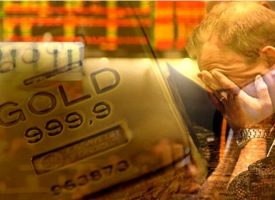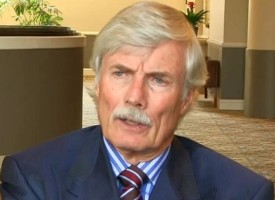More big money is flowing into gold as we kickoff trading in the month of February, plus a look at more inflation and a huge problem.
More Big Money Flowing Into Gold
February 1 (King World News) – Fred Hickey: Another 3 1/2 tons inflows into GLD today. That makes it 41.5 tons in past 9 biz days, Rock & Roll Hall of Fame band Buffalo Springfield started their most famous song with the lyrics: “There’s something happening here” What’s happening is – US institutions are back buying gold…
To find out which gold & copper explorer just hit significant mineralization click here or on the image below

Fed’s Big Problem
Otavio Costa: Outlook for wages and salaries just reached new highs while business activity is weakening. Profit margins are about to get squeezed from peak levels. How does the Fed tighten financial conditions in this environment?
Fed’s Problem Is Weakening Economy And High Inflation…Stagflation Like 1970s, But Even Worse
Fed Propaganda
Peter Boockvar: Here’s a quick summary of all the Fed speak yesterday but only one was from a voting member, Esther George.
1) George acknowledges that the Fed is behind the curve, “With inflation running at close to a 40 yr high, considerable momentum in demand growth, and abundant signs and reports of labor market tightness, the current very accommodative stance of monetary policy is out of sync with the economic outlook.” She talked about the bumpy transition ahead, particularly with “asset valuation adjustments.” After getting going with rate hikes, she seems to be focused on where the yield curve goes in terms of calibrating rate hikes with balance sheet shrinkage. She thinks that more QT would avoid curve flattening from rate hikes. I say, easier said than done on that based on the opposite yield curve responses to the end of QE and QT.
2) Mary Daly, still showing her dovish stance said “We are not behind the curve.” So, they are still increasing the balance sheet for another month and half and the REAL fed funds rate is at -7%, more than what we saw in the 1970’s, but she says “we are not behind the curve.” She has no interest thus in being bold with tightening and you “have to be gradual and not disruptive” with respect to it.
3) Tom Barkin on CNBC echoed the ‘data dependence’ line and said the direction of the stock market is not going to stop them from doing what they feel they need to do. He talked about the very tight labor market and sees consumer demand as strong and thus able to weather rate hikes. He also was not concerned with the recent flattening of the yield curve in response to a question about it. “There is just a lot of global money that trades at the longer end of the yield curve, and I have a hard time making much out of it, in that context.”
4) Raphael Bostic elaborated on his FT interview with respect to the 50 bps comment and in a Yahoo Finance interview said that pace “is not my preferred setting of policy action at the next meeting.” He wants to get a few hikes in 25 bps increments under their belt and then see what happens.
Gold Bounces Back Above $1,800
I’m not sure if I can draw the line between the somewhat kid gloves approach to tightening that seemed to be expressed yesterday and the dollar weakness the past 2 days after the sharp run up last week but we’re watching. Either that or maybe it’s in response to the jump in yields overseas, particularly in Europe over the past week. Gold also bounced back above $1800.
Bottom line, while some will talk tough on inflation, gradual will still be the most likely path on tightening. It seems most likely that after ending QE and hiking rates 25 bps in March and May, the Fed will then take a lay of the land and go from there. At that point monetary policy will still be uber easy but the Fed I think realizes that they are juggling a bunch of different interests as like I’ve said before, how do they tame consumer price inflation without sticking the pin into asset price inflation and at the same time not hurting the economy that is already slowing.
Australia
The Reserve Bank of Australia said no more to QE. They said in a statement as they still left their benchmark rate at just .10%, “The decision to end purchases under the bond purchase program follows a review of the actions of other central banks, the functioning of Australia’s bond market and the progress towards the goals of full employment and inflation consistent with target.” With respect to what comes next, they are still dovish, “Ceasing purchases under the bond purchase program does not imply a near term increase in interest rates.” Even though inflation is running at 3.5%, “the Board is prepared to be patient as it monitors how the various factors affecting inflation in Australia evolve.” Unfortunately, too much patience is why so many central banks are all in the same pickle of presiding over too high inflation. Yields didn’t move much in response as it was not much of a surprise but the Aussie$ is higher as was the ASX.
“Rent To Damn High”
Last week Apartment List’s National Rent Report came out and it showed a .2% m/o/m increase in January. Versus last year they are up a whopping 17.8% “but over the past four months, rents have increased by a total of just .9%.
Much of this cooldown is likely related to seasonal factors; it remains to be seen if rapid rent growth will return as moving activity picks back up in the spring and summer.” While these figures measure NEW rents only rather than combining with renewals, the aggregate rental increases are less than the headline but it is still in the double digits and the government numbers are still way underreporting actual housing inflation. For those looking for a roof over their head without spending all of their income, let’s hope this is the beginning of a broader cooldown. But, either way, the cost of housing has risen dramatically over the past few years.
NYC led the rental increases but even with the sharp rebound, “rents in NYC are now just 4.4% higher than they were in March 2020. In contrast, Tampa never experienced a meaningful decline in rents at the start of the pandemic, and rents there are now 34.3% higher than they were in March 2020.”
Inflation And Bond Market Risk
After hotter than expected German and Spanish CPI prints for January ahead of the Thursday ECB meeting, France today said its CPI rose .1% m/o/m and 3.3% y/o/y, above the estimates of down .2% and up 2.9% respectively. Yes, energy prices jumped but services inflation also quickened to 2%. The French 10 yr inflation breakeven is down 1.3 bps but only after rising by 21 bps in the prior 5 trading days. At 1.85% it is just off the highest since 2013. After yesterday’s jump, sovereign bond yields are a hair lower but if there is real bond market risk in the world, it is in Europe.
German said its January employment report was solid as the number of unemployed fell a sharp 48k, well more than the estimate of down 6k. Also, their unemployment rate fell to 5.1%, down a tenth m/o/m. It was at 5% in February 2020. Considering that the German economy contracted in Q4, it is a good start to 2022. This could also be a reason why the euro is bouncing for a 2nd day.
Europe
Finally in Europe, the January Eurozone manufacturing index was revised slightly lower to 58.7 from its initial print of 59 but up from 58 in December. It’s clear that powering thru omicron has been easier than previous strains. “Prospects have also brightened, with a further easing in the number of supply chain delays playing a key role in prompting producers to revise up their expectations for growth in the coming year to the highest since last June” said Markit. But, it’s not all clear with supply and price pressures, “although the number of supply delays has fallen from the peak last year, lead times remain stretched for many critical inputs and for a wide variety of capital equipment, constraining output and resulting in sustained high price pressures. Average prices charged for goods leaving the factory gate rose at the 2nd highest rate in almost two decades, which points to inflation remaining elevated in coming months.”
UK
The UK manufacturing PMI for January was revised up to 57.3 from the 1st print of 56.9. That is still down .6 pts from December. It’s a mixed bag though according to Markit. On one hand, it’s been “a solid start to 2022, showing encouraging resilience in the face of the omicron wave, with growth of output accelerating as companies reported fewer supply delays.” But, “Causes for concern remain, however, as new orders growth slowed, exports barely rose, staff absenteeism remained high and manufacturers’ ongoing caution regarding supply chain disruptions led to the beefing up of safety stocks.” On the pricing and supply front, supplier lead times did slow and “This also lessened the upward pressure on prices, with input costs and output charges both rising at less elevated rates in January.” I’ve argued for a while the cheapness of the UK stock market and it happens to be one of the best performing global markets in 2022, up 2% year to date with the shift to value parts of the global market.
Japan
Japan’s manufacturing PMI was revised up to 55.4 from 54.3 in December. Output rose at a near 8 yr high and new orders were up too but again this caveat, “The rise in demand was coupled with sustained reports of supply chain pressures as delivery delays and material shortages continued to weigh on input costs. Manufacturers were increasingly unable to absorb these increases, which resulted in the sharpest rise in output prices since July 2008.” The 10 yr JGB yield is now at .18%, just 2 bps from the upper limit of BoJ yield curve control. I still like Japanese stocks.
Japan also said its unemployment rate fell to 2.7% from 2.8%. It was as low as 2.2% at the end of 2019. The jobs to applicant ratio rose to 1.16 from 1.15 as expected, matching the highest since May 2020 but still well below its highs seen in 2018 and 2019 when it got as high as 1.64. We know the Japanese population continues to age and overall shrink and the pressure on the government to rely more on immigration for economic growth will only grow this decade.
To listen to Dr. Stephen Leeb discuss what is next for the gold and silver markets and much more CLICK HERE OR ON THE IMAGE BELOW.
To listen to Alasdair Macleod discuss what is next for the gold and silver markets CLICK HERE OR ON THE IMAGE BELOW.
© 2022 by King World News®. All Rights Reserved. This material may not be published, broadcast, rewritten, or redistributed. However, linking directly to the articles is permitted and encouraged.












